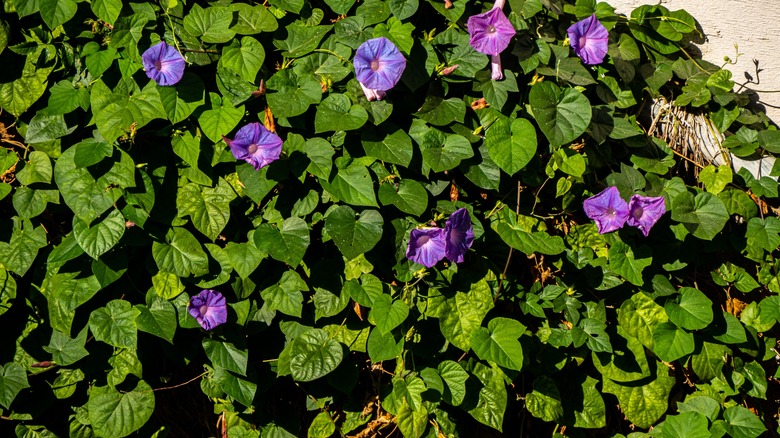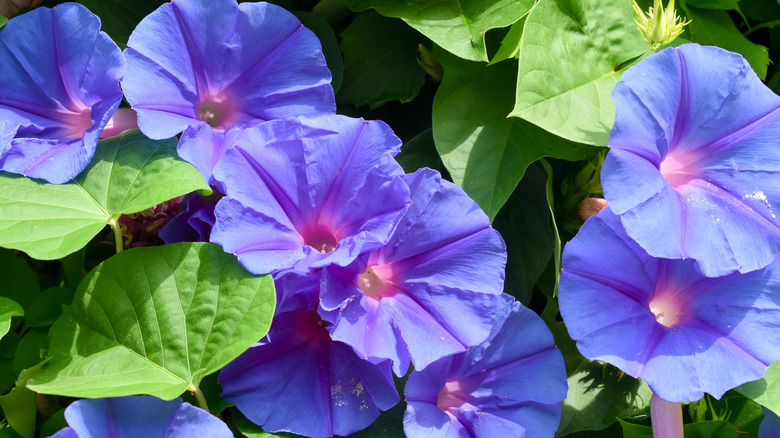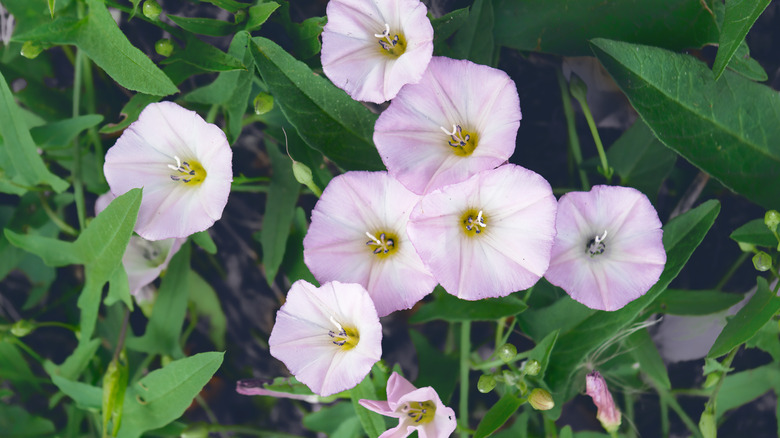How To Tell If Your Morning Glories Are A Beautiful Addition Or An Invasive Pest
Morning glories are gorgeous. Or, you may see them as an invasive species to be eradicated. It depends on who you ask since "morning glory" is a name used for several kinds of flowers. The most popular is the Ipomoea purpurea, or the common morning glory. These are known for their vining growth habit and gorgeous multicolored trumpet-shaped flowers ideal for impatient gardeners. The enemies, however, are Convolvulus arvensis, or field bindweed. They're extremely similar since they have the same vining growth and trumpet flowers, but the main difference is that field bindweed is invasive and can choke out native species with their relentless growth habit.
It's important to be able to tell the difference between these two species. Common morning glories are still able to take over other plants, but they're much easier to control than bindweed. Bindweed can spread quickly and easily grow out of control when you're not looking. If you're trying to grow native plants to attract native species, field bindweed can greatly hinder your efforts.
The good morning glories: Ipomoea purpurea
These gorgeous flowers come in shades of red, purple, pink, blue, and white. Their long vines are ideal for bare spots in your garden like fences and railings. Their large, heart-shaped leaves are pretty enough on their own, but their striped flowers will add extra beauty to the landscape. These lovely leaves are one of the tell-tale ways to identify common morning glories against field bindweed. Remember that if the leaves look like hearts, you'll love to grow them.
Another way to tell them apart is to remember that Ipomoea purpurea are annuals. They spread by dropping seeds each year. They won't come back on the same vines since the plant dies each year; new ones will grow next year. You can deadhead the flowers before they wilt and drop seeds to prevent the spread, making them much easier to contain than bindweed. Should morning glories become a problem in your garden, they won't take as much effort to eradicate them. It's easy to successfully grow morning glories and they're fast growers, so plant them with careful consideration of other plants nearby.
The bad morning glories: Convolvulus arvensis
Field bindweed isn't a morning glory, but they're sometimes mistaken for flowers because they look so similar. Bindweed is only available in pink and white, whereas morning glories have more color variants. The leaves look like arrowheads or shovels, a key sign that you should dig this one up. The flowers are certainly beautiful, but this plant's invasive tendencies could be detrimental to the local ecosystem, depending on the circumstances. Allowing them to grow in a flower bed may not be an issue if you have other flowerbeds filled with native species. But, if you let these plants take over the native ones they become an issue because they're taking over native pollinators' food supply.
Some people may find these flowers impossible to get rid of because they spread like wildfire. Not only do they self-seed, but they also spread by rhizomes. These perennial plants will come back on the same growth each year. Their rhizomes will develop new shoots; even if you try to dig them up, any rhizome chunks left behind can start a new plant. Between the rhizomes and seeds, it could take a few years to eliminate them from your garden.


